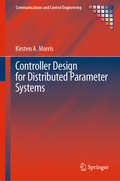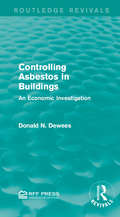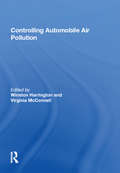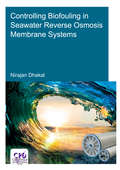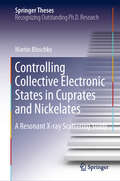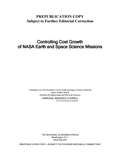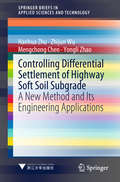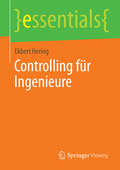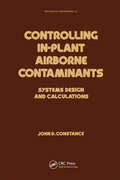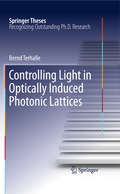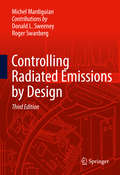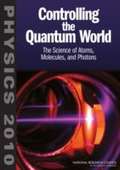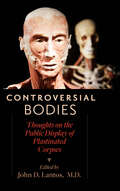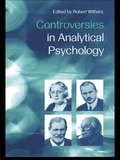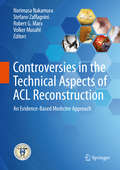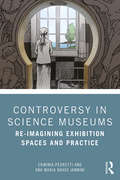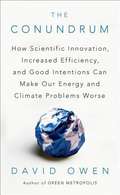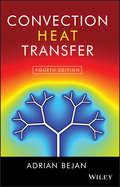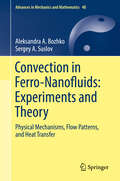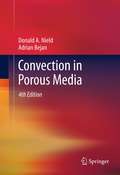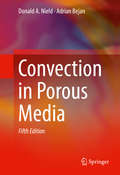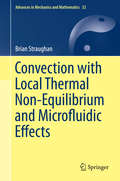- Table View
- List View
Controller Design for Distributed Parameter Systems (Communications and Control Engineering)
by Kirsten A. MorrisThis book addresses controller and estimator design for systems that vary both spatially and in time: systems like fluid flow, acoustic noise and flexible structures. It includes coverage of the selection and placement of actuators and sensors for such distributed-parameter systems. The models for distributed parameter systems are coupled ordinary/partial differential equations. Approximations to the governing equations, often of very high order, are required and this complicates both controller design and optimization of the hardware locations. Control system and estimator performance depends not only on the controller/estimator design but also on the location of the hardware. In helping the reader choose the best location for actuators and sensors, the analysis provided in this book is crucial because neither intuition nor trial-and-error is foolproof, especially where multiple sensors and actuators are required, and moving hardware can be difficult and costly. The mechatronic approach advocated, in which controller design is integrated with actuator location, can lead to better performance without increased cost. Similarly, better estimation can be obtained with carefully placed sensors. The text shows how proper hardware placement varies depending on whether, disturbances are present, whether the response should be reduced to an initial condition or whether controllability and/or observability have to be optimized. This book is aimed at non-specialists interested in learning controller design for distributed-parameter systems and the material presented has been used for student teaching. The relevant basic systems theory is presented and followed by a description of controller synthesis using lumped approximations. Numerical algorithms useful for efficient implementation in real engineering systems and practical computational challenges are also described and discussed.
Controlling Asbestos in Buildings: An Economic Investigation (Routledge Revivals)
by Donald N. DeweesAsbestos dust is well-known for causing cancer and other life-threatening illnesses yet still contaminates countless schools, factories and office buildings. This raises the issue of the best way to deal with Asbestos; immediate removal, containment or removal at renovation or demolition. Originally published in 1986, this report aims to evaluate these methods of dealing with asbestos in relation to their cost-effectiveness to conclude the most appropriate solution. This title will be of interest to students of Environmental Studies and Economics.
Controlling Automobile Air Pollution (The\international Library Of Environmental Economics And Policy Ser.)
by Virginia McConnellThis volume includes many of the most influential and interesting academic articles related to the economics of mobile source pollution control. The papers included explore why vehicles and vehicle markets are unique, provide estimates of the type and magnitude of the social costs of driving and examine estimation methods and estimates of the various elasticities of vehicle demand. Analysis of the social costs and policies to reduce both traditional air pollutants and greenhouse gas emissions are included. Selected articles review the range of evaluation of both regulatory and market-based approaches to controlling emissions. The complexity of the effects of different policies are emphasized and the unintended consequences of regulation are explored in the context of vehicle emissions reduction policies.
Controlling Biofouling in Seawater Reverse Osmosis Membrane Systems (IHE Delft PhD Thesis Series)
by Nirajan DhakalSeawater desalination is a rapidly growing coastal industry that is increasingly threatened by algal blooms. Depending on the severity of algal blooms, desalination systems may be forced to shut down because of clogging and/or poor feed water quality. To maintain stable operation and provide good feed water quality to seawater reverse osmosis (SWRO) systems, ultrafiltration (UF) pre-treatment is proposed.This research focused on assessing the ability of UF and other pre-treatment technologies to reduce biofouling in SWRO systems. An improved method to measure bacterial regrowth potential (BRP) was developed and applied at laboratory, pilot and full scale to assess the ability of conventional UF (150 kDa) and tight UF (10 kDa) alone and in combination with a phosphate adsorbent to reduce regrowth potential and delay the onset of biofouling in SWRO.The improved bacterial regrowth potential method employs a natural consortium of marine bacteria as inoculum and flow cytometry. The limit of detection of the BRP method was lowered to 43,000 ± 12,000 cells/mL, which is equivalent to 9.3 ± 2.6 µg-Cglucose/L.The reduction in bacterial regrowth potential after tight UF (10 kDa) was 3 to 4 times higher than with conventional UF (150 kDa). It was further reduced after the application of a phosphate adsorbent, independent of pore size of the UF membrane. Pilot studies demonstrated that the application of tight UF (10 kDa) coupled with a phosphate adsorbent consistently lowered the bacterial regrowth potential and no feed channel pressure drop increase was observed in membrane fouling simulators (MFS) over a period of 21 days. The study also showed that non-backwashable fouling of UF membranes varied strongly with the type of algal species and the algal organic matter (AOM) they release. The presence of polysaccharide (stretching -OH) and sugar ester groups (stretching S=O) was the main cause of non-backwashable fouling.In conclusion, this study showed that an improved BRP method is suitable for the assessment of SWRO pre-treatment systems and it can be a useful tool to develop potential strategies to mitigate biofouling and improve the sustainability of SWRO systems.
Controlling Collective Electronic States in Cuprates and Nickelates: A Resonant X-ray Scattering Study (Springer Theses)
by Martin BluschkeIn this thesis chemical and epitaxial degrees of freedom are used to manipulate charge and spin ordering phenomena in two families of transition metal oxides, while taking advantage of state-of-the-art resonant x-ray scattering (RXS) methods to characterize their microscopic origin in a comprehensive manner. First, the relationship of charge density wave order to both magnetism and the "pseudogap" phenomenon is systematically examined as a function of charge-carrier doping and isovalent chemical substitution in single crystals of a copper oxide high-temperature superconductor. Then, in copper oxide thin films, an unusual three-dimensionally long-range-ordered charge density wave state is discovered, which persists to much higher temperatures than charge-ordered states in other high-temperature superconductors. By combining crystallographic and spectroscopic measurements, the origin of this phenomenon is traced to the epitaxial relationship with the underlying substrate. This discovery opens new perspectives for the investigation of charge order and its influence on the electronic properties of the cuprates. In a separate set of RXS experiments on superlattices with alternating nickel and dysprosium oxides, several temperature- and magnetic-field-induced magnetic phase transitions are discovered. These observations are explained in a model based on transfer of magnetic order and magneto-crystalline anisotropy between the Ni and Dy subsystems, thus establishing a novel model system for the interplay between transition-metal and rare-earth magnetism.
Controlling Cost Growth of NASA Earth and Space Science Missions
by National Research Council of the National AcademiesCost and schedule growth is a problem experienced by many types of projects in many fields of endeavor. Based on prior studies of cost growth in NASA and Department of Defense projects,this book identifies specific causes of cost growth associated with NASA Earth and space science missions and provides guidance on how NASA can overcome these specific problems. The recommendations in this book focus on changes in NASA policies that would directly reduce or eliminate the cost growth of Earth and space science missions. Large cost growth is a concern for Earth and space science missions,and it can be a concern for other missions as well. If the cost growth is large enough,it can create liquidity problems for NASA's Science Mission Directorate that in turn cause cost profile changes and development delays that amplify the overall cost growth for other concurrent and/or pending missions. Addressing cost growth through the allocation of artificially high reserves is an inefficient use of resources because it unnecessarily diminishes the portfolio of planned flights. The most efficient use of resources is to establish realistic budgets and reserves and effective management processes that maximize the likelihood that mission costs will not exceed reserves. NASA is already taking action to reduce cost growth; additional steps,as recommended herein,will help improve NASA's mission planning process and achieve the goal of ensuring frequent mission opportunities for NASA Earth and space science.
Controlling Differential Settlement of Highway Soft Soil Subgrade: A New Method And Its Engineering Applications (SpringerBriefs in Applied Sciences and Technology)
by Yongli Zhao Mengchong Chen Zhijun Wu Hanhua ZhuDrawing on years of practical on-site experience, this book presents a new method for controlling "bridge-head bumping" in soft soil ground. Based on deformation compatibility and control theory of structure, it proposes strategies for improving the design method of soft soil ground and the effective "bridge-head bumping" control method. Soft soil ground is chiefly characterized by a large void ratio, high compressibility, high water content, low impermeability, low strength, strong structure and high sensitivity. As a result, it has pronounced rheological properties, and controlling "bridge-head bumping" in soft soil ground is essential to control the amount of soil rheology-induced unstable successive settlement. The book offers extensive information on this and related topics, making it a valuable guide for engineers in Civil Engineering and Geotechnical Engineering alike.
Controlling für Ingenieure (essentials)
by Ekbert HeringControlling stellt ein ziel-, nutzen- und engpassorientiertes Führungskonzept dar, mit dem Unternehmen kurz-, mittel- und langfristig erfolgreich geführt werden können. Die Ziele werden in Planungen festgehalten, die messbare Soll-Werte enthalten. Werden die tatsächlichen Ist-Werte gemessen, so kann man die Abweichungen von den Planwerten feststellen. Diese Abweichungen lösen eine Steuerung durch Anpassungsmaßnahmen zur Zielerreichung oder Korrektur der Zielgrößen aus. Es wird zwischen strategischem und operativem Controlling unterschieden. Das strategische Controlling dient zur Existenzsicherung, indem es die langfristigen Ziele anhand der Erkenntnisse über zukünftige Marktchancen und -risiken unter Berücksichtigung der eigenen Möglichkeiten und Stärken festlegt. Aufgabe des operativen Controllings ist die Sicherung der Lebensfähigkeit des Unternehmens (Liquidität), einer angemessenen Verzinsung des eingesetzten Kapitals (Rentabilität) sowie ein optimales Kosten- und Leistungsverhältnis (Wirtschaftlichkeit). Strategisches und operatives Controlling werden für alle Funktionen des Unternehmens erläutert.
Controlling In-Plant Airborne Contaminants: Systems Design and Calculations
by John D. ConstanceThis book is a useful reference work for practicing engineers in their evaluation and design of systems for the control of the industrial in-plant environment. It provides design criteria, useful calculations and proven techniques to control the environment in oil refineries and chemical industries.
Controlling Light in Optically Induced Photonic Lattices (Springer Theses)
by Bernd TerhalleDiscrete periodic structures play an important role in physics, and have opened up an exciting new area of investigation in recent years. Questions relating to the control of light in such structures still represent a major challenge. It is this highly active field that is addressed in the present thesis. Using the model system of a photorefractive nonlinearity that allows one to simultaneously create and control photonic lattices by light, the author obtains a comprehensive picture of the control of nonlinear and quantum optics phenomena in photonic lattices. He describes and demonstrates experimentally for the first time resonant transitions in two-dimensional hexagonal lattices, including Rabi oscillations and Landau-Zener tunneling, as well as the direct control and exploitation of these transitions. A particular highlight of this thesis is the study of soliton-cluster switching and control of Zener tunneling.
Controlling Radiated Emissions by Design (The\springer International Series In Engineering And Computer Science Ser. #580)
by Michel MardiguianThe 3rd edition of Controlling Radiated Emissions by Design has been updated to reflect the latest changes in the field. New to this edition is material on aspects of technical advance, specifically long term energy efficiency, energy saving, RF pollution control, etc. This book retains the step-by-step approach for incorporating EMC into every new design, from the ground up. It describes the selection of quieter IC technologies, their implementation into a noise-free printed circuit layout, and the gathering of all these into low radiation packaging, including I/O filtering, connectors and cables considerations. All guidelines are supported by thorough and comprehensive calculated examples. Design engineers, EMC specialists and technicians will benefit from learning about the development of more efficient and economical control of emissions.
Controlling the Quantum World: The Science of Atoms, Molecules, and Photons
by National Research Council of the National AcademiesAs part of the Physics 2010 decadal survey project, the Department of Energy and the National Science Foundation requested that the National Research Council assess the opportunities, over roughly the next decade, in atomic, molecular, and optical (AMO) science and technology. In particular, the National Research Council was asked to cover the state of AMO science, emphasizing recent accomplishments and identifying new and compelling scientific questions. Controlling the Quantum World, discusses both the roles and challenges for AMO science in instrumentation; scientific research near absolute zero; development of extremely intense x-ray and laser sources; exploration and control of molecular processes; photonics at the nanoscale level; and development of quantum information technology. This book also offers an assessment of and recommendations about critical issues concerning maintaining U.S. leadership in AMO science and technology.
Controlling the Quantum World of Atoms, Molecules, and Photons: An Interim Report
by National Research Council of the National AcademiesAs part of its Physics 2010 decadal survey, the NRC has undertaken a study of opportunities in atomic, molecular, and optical (AMO) science and technology over roughly the next decade. This study has been requested by the Department of Energy and the National Science Foundation. They asked the NRC to assess the state of AMO science, emphasizing recent accomplishments and identifying new and compelling scientific questions. A final report on this study is expected in the summer 2006. This interim report provides a preview of the final document. It presents a summary of the key opportunities in forefront AMO science and in closely related technologies, and a discussion of some of the broad-scale conclusions of the final report. The interim report also describes how AMO science supports national R&D priorities.
Controversial Bodies: Thoughts on the Public Display of Plastinated Corpses
by John D. LantosControversial, fascinating, disturbing, and often beautiful, plastinated human bodies—such as those found at Body Worlds exhibitions throughout the world—have gripped the public's imagination. These displays have been lauded as educational, sparked protests, and drawn millions of visitors. This book looks at the powerful sway these corpses hold over their living audiences everywhere.Plastination was invented in the 1970s by German anatomist Gunther von Hagens. The process transforms living tissues into moldable plastic that can then be hardened into a permanent shape. Von Hagens first exhibited his expertly dissected, artfully posed plastinated bodies in Japan in 1995. Since then, his shows have continuously attracted so many paying customers that they have inspired imitators, brought accusations of unethical or even illegal behavior, and ignited vigorous debates among scientists, educators, religious leaders, and law enforcement officials. These lively, thought-provoking, and sometimes personal essays reflect on such public displays from ethical, legal, cultural, religious, pedagogical, and aesthetic perspectives. They examine what lies behind the exhibitions' popularity and explore the ramifications of turning corpses into a spectacle of amusement. Contributions from bioethicists, historians, physicians, anatomists, theologians, and novelists dig deeply into issues that compel, upset, and unsettle us all.
Controversies in Analytical Psychology
by Robert WithersHow can controversy promote mutual respect in analytical psychology?Analytical psychology is a broad church, and influences areas such as literature, cultural studies, and religion. However, in common with psychoanalysis, there are many different schools of thought and practice which have resulted in divisions within the field. Controversies in Analytical Psychology picks up on these and explores many of the most hotly contested issues in and around analytical psychology.A group of leading international Jungian authors have contributed papers from contrasting perspectives on a series of key controversies. Some of these concern clinical issues such as what helps patients get better, or how closely analysts should work with the transference. Other contributions focus on the relationship between analytical psychology and other disciplines including evolutionary theory, linguistics, politics and religion. A critical eye is cast over Jungian theories and practices, and a number of questions are raised:* are they homophobic?* do they denigrate women?* do they confuse absolute with narrative truth?* are the frequency of sessions chosen for political rather than clinical reasons?Controversies in Analytical Psychology encourages critical thinking on a variety of issues, helping foster dialogue and investigation in a climate of mutual respect and understanding. It will be invaluable for Jungian analysts and psychoanalysts in training and practice and psychotherapists.
Controversies in Obstetric Anesthesia and Analgesia
by Ian McconachieMcConachie (anesthesia and perioperative medicine, U. of Western Ontario, Canada) assembles 21 articles by obstetrics practitioners caring for high-risk patients at the University of Western Ontario and in the UK who outline debates in obstetric anesthesia and analgesia used in the perioperative and perinatal periods, for trainees and practitioners in anesthesia, obstetrics, and critical care medicine, as well as nurses and midwives. They address substance abuse and cardiac disease in pregnancy; management of pre-eclampsia and eclampsia, hemorrhage, and postdural puncture headache; anesthetic drugs and the developing fetal brain; ultrasound-guided epidural anesthesia, combined spinal-epidural anesthesia, and other types; coagulation and regional anesthesia; ambulatory and patient-controlled epidural analgesia; hypotension following spinal anesthesia; outcomes; cesarean section airway management, oxygen supplementation, oxytocin use and dosage, and analgesia; and other topics. Basic knowledge and experience in obstetric physiology, pharmacology, and anesthesia is assumed. Annotation ©2012 Book News, Inc. , Portland, OR (booknews. com)
Controversies in the Technical Aspects of ACL Reconstruction: An Evidence-Based Medicine Approach
by Stefano Zaffagnini Robert G. Marx Norimasa Nakamura Volker MusahlThis book provides the reader with the best available evidence on the most pressing issues relating to reconstruction of the anterior cruciate ligament (ACL) with the goal of supporting surgical reconstruction of the ACL and improving outcomes for patients. Key topics for which evidence-based information is presented include selection of graft material and source, the use of different surgical techniques, graft rupture in relation to surgical technique, and progression to osteoarthritis. The book will aid the surgeon in making decisions with respect to fixation devices and tensioning, the bundles to be reconstructed, and whether to preserve remnants or partial bundle ruptures. An evidence-based stance is taken on evolving topics such as the anatomy of the tibial insertion site of the ACL and the role of the anterolateral capsule and posteromedial corner in high-grade rotatory instability. Furthermore, novel technical developments for measurement of knee laxity and soft tissue navigation are discussed. The reader will also find useful information on general issues concerning physical examination, arthroscopic setup, timing of reconstruction, anesthesia, and anticoagulation.
Controversy in Science Museums: Re-imagining Exhibition Spaces and Practice
by Erminia Pedretti Ana Maria Navas IanniniControversy in Science Museums focuses on exhibitions that approach sensitive or controversial topics. With a keen sense of past and current practices, Pedretti and Navas Iannini examine and re-imagine how museums and science centres can create exhibitions that embrace criticality and visitor agency. Drawing on international case studies and voices from visitors and museum professionals, as well as theoretical insights about scientific literacy and science communication, the authors explore the textured notion of controversy and the challenges and opportunities practitioners may encounter as they plan for and develop controversial science exhibitions. They assert that science museums can no longer serve as mere repositories for objects or sites for transmitting facts, but that they should also become spaces for conversations that are inclusive, critical, and socially responsible. Controversy in Science Museums provides an invaluable resource for museum professionals who are interested in creating and hosting controversial exhibitions, and for scholars and students working in the fields of museum studies, science communication, and social studies of science. Anyone wishing to engage in an examination and critique of the changing roles of science museums will find this book relevant, timely, and thought provoking.
The Conundrum: How Scientific Innovation, Increased Efficiency, and Good Intentions Can Make Our Energy and Climate Problems Worse
by David OwenThe Conundrum is a mind-changing manifesto about the environment, efficiency, and the real path to sustainability.
Convection Heat Transfer
by Adrian BejanA new edition of the bestseller on convection heat transfer A revised edition of the industry classic, Convection Heat Transfer, Fourth Edition, chronicles how the field of heat transfer has grown and prospered over the last two decades. This new edition is more accessible, while not sacrificing its thorough treatment of the most up-to-date information on current research and applications in the field. One of the foremost leaders in the field, Adrian Bejan has pioneered and taught many of the methods and practices commonly used in the industry today. He continues this book's long-standing role as an inspiring, optimal study tool by providing: Coverage of how convection affects performance, and how convective flows can be configured so that performance is enhanced How convective configurations have been evolving, from the flat plates, smooth pipes, and single-dimension fins of the earlier editions to new populations of configurations: tapered ducts, plates with multiscale features, dendritic fins, duct and plate assemblies (packages) for heat transfer density and compactness, etc. New, updated, and enhanced examples and problems that reflect the author's research and advances in the field since the last edition A solutions manual Complete with hundreds of informative and original illustrations, Convection Heat Transfer, Fourth Edition is the most comprehensive and approachable text for students in schools of mechanical engineering.
Convection in Ferro-Nanofluids: Physical Mechanisms, Flow Patterns, and Heat Transfer (Advances in Mechanics and Mathematics #40)
by Aleksandra A. Bozhko Sergey A. SuslovThis book covers the experimental and theoretical study of convection in non-isothermal ferro-nanofluids (FNFs). Since FNFs are not transparent and magnetic fields are very sensitive to the shape of the boundary between magnetic and nonmagnetic media, special flow visualization techniques based on the use of thermo-sensitive liquid crystal films, infrared cameras, as well as local and integral temperature sensors are discussed in the book. This book considers several major configurations of convective chambers and the applied magnetic field. For each of them, the stability boundaries are determined theoretically and experimentally. The physical types of dominant instabilities and the characteristics of their interactions are subsequently established using linear and weakly non-linear hydrodynamic stability analyses and elements of bifurcation theory. The book also discusses the potential of using magnetically controlled ferro-nanofluids as a heat carrier in situations where heat removal by natural convection is not possible due to the lack of gravity (orbital stations) or extreme confinement (microelectronics). Researchers and practitioners working in the areas of fluid mechanics, hydrodynamic stability, and heat and mass transfer will benefit from this book.
Convection in Porous Media
by Adrian Bejan Donald A. NieldConvection in Porous Media, 4th Edition, provides a user-friendly introduction to the subject, covering a wide range of topics, such as fibrous insulation, geological strata, and catalytic reactors. The presentation is self-contained, requiring only routine mathematics and the basic elements of fluid mechanics and heat transfer. The book will be of use not only to researchers and practicing engineers as a review and reference, but also to graduate students and others entering the field. The new edition features approximately 1,750 new references and covers current research in nanofluids, cellular porous materials, strong heterogeneity, pulsating flow, and more.
Convection in Porous Media
by Adrian Bejan Donald A. NieldThis updated edition of a widely admired text provides a user-friendly introduction to the field that requires only routine mathematics. The book starts with the elements of fluid mechanics and heat transfer, and covers a wide range of applications from fibrous insulation and catalytic reactors to geological strata, nuclear waste disposal, geothermal reservoirs, and the storage of heat-generating materials. As the standard reference in the field, this book will be essential to researchers and practicing engineers, while remaining an accessible introduction for graduate students and others entering the field. The new edition features 2700 new references covering a number of rapidly expanding fields, including the heat transfer properties of nanofluids and applications involving local thermal non-equilibrium and microfluidic effects.
Convection in Porous Media
by Donald A. Nield Adrian BejanThis updated edition of a widely admired text provides a user-friendly introduction to the field that requires only routine mathematics. The book starts with the elements of fluid mechanics and heat transfer, and covers a wide range of applications from fibrous insulation and catalytic reactors to geological strata, nuclear waste disposal, geothermal reservoirs, and the storage of heat-generating materials. As the standard reference in the field, this book will be essential to researchers and practicing engineers, while remaining an accessible introduction for graduate students and others entering the field. The new edition features 2700 new references covering a number of rapidly expanding fields, including the heat transfer properties of nanofluids and applications involving local thermal non-equilibrium and microfluidic effects.
Convection with Local Thermal Non-Equilibrium and Microfluidic Effects (Advances in Mechanics and Mathematics #32)
by Brian StraughanThis book is one of the first devoted to an account of theories of thermal convection which involve local thermal non-equilibrium effects, including a concentration on microfluidic effects. The text introduces convection with local thermal non-equilibrium effects in extraordinary detail, making it easy for readers newer to the subject area to understand. This book is unique in the fact that it addresses a large number of convection theories and provides many new results which are not available elsewhere. This book will be useful to researchers from engineering, fluid mechanics, and applied mathematics, particularly those interested in microfluidics and porous media.
